
A knife is a tool or weapon with a cutting edge or blade, usually attached to a handle or hilt. One of the earliest tools used by humanity, knives appeared at least 2.5 million years ago, as evidenced by the Oldowan tools. Originally made of wood, bone, and stone, over the centuries, in step with improvements in both metallurgy and manufacturing, knife blades have been made from copper, bronze, iron, steel, ceramic, and titanium. Most modern knives have either fixed or folding blades; blade patterns and styles vary by maker and country of origin.
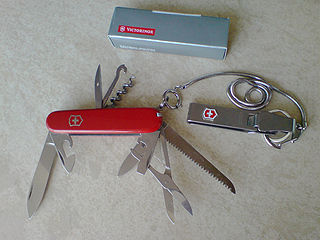
The Swiss Army knife is a pocketknife, generally multi-tooled, now manufactured by Victorinox. The term "Swiss Army knife" was coined by American soldiers after World War II after they had trouble pronouncing the German word "Offiziersmesser", meaning "officer’s knife".

A switchblade is a pocketknife with a sliding or pivoting blade contained in the handle which is extended automatically by a spring when a button, lever, or switch on the handle or bolster is activated. Virtually all switchblades incorporate a locking blade, where the blade is locked against accidental closure when the blade is in the open position. It is unlocked by a mechanism that allows the blade to be folded and locked in the closed position.

Victorinox is a knife manufacturer and watchmaker based in the town of Ibach, in the Canton of Schwyz, Switzerland. It is well known for its Swiss Army knives. The Swiss Army knives made by Victorinox are made of a proprietary blend hardened steel from Germany and France. Since its acquisition of rival Wenger in 2005, it has become the sole supplier of multi-purpose knives to the Swiss army. It is the biggest manufacturer of pocket knives in the world; in addition, the company licenses its logo for watches, apparel, and travel gear.
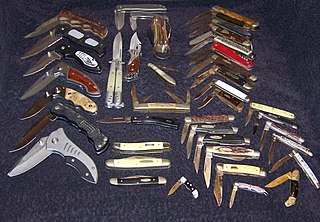
A pocketknife is a knife with one or more blades that fold into the handle. They are also known as jackknives (jack-knife), folding knives, EDC knife, or may be referred to as a penknife, though a penknife may also be a specific kind of pocketknife. Blade lengths typically range from 5 to 15 centimetres. Some pocketknives have multiple tools in addition to one or more blades.
A gravity knife is a knife with a blade contained in its handle, and that opens its blade through the force of gravity. This mechanism of opening is fundamentally different from the switchblade, which extends its spring-propelled blade automatically upon the push of a button, switch, or fulcrum lever. The main purpose of gravity opening is that it allows opening and closing to be done one handed, in situations where the other hand is occupied. Hence, historically they have been issued to parachutists to cut off caught lines, such as lines tangled in trees, a major potential use of the gravity knife.

The Opinel company has manufactured and marketed a line of eponymous wooden-handled knives since 1890 from its headquarters in Saint-Jean-de-Maurienne, Savoie, France where the family-run company also operates a museum dedicated to its knives. The company sells approximately 15 million knives annually. Opinel knives are made of both high carbon and stainless steel, the latter being Sandvik steel from Sweden.
The Laguiole knife is a traditional Occitan pocketknife, originally produced in the "knife city" of Thiers, source of 70% of France's cutting tool production, as well as the small village of Laguiole, both located in the Massif central region of France. Laguiole in this instance does not refer to the French knife brand but to a generic type of traditional slipjoint knife associated with this region of France.

Buck Knives is an American knife manufacturer founded in Mountain Home, Idaho and now located in Post Falls, Idaho. The company has a long history through five generations of the Buck family from 1902 to the present day. Buck Knives primarily manufactures sport and field knives and is credited with inventing the "folding hunting knife" and popularizing it to such a degree that the term "buck knife" has become synonymous with folding lockback knives, including those made by other manufacturers.
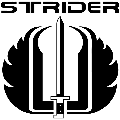
Strider Knives, Inc. is a custom and production knifemaking facility headed by Mick Strider based in San Marcos, California.
In cooking, a chef's knife, also known as a cook's knife, is a cutting tool used in food preparation. The chef's knife was originally designed primarily to slice and disjoint large cuts of beef. Today it is the primary general-utility knife for most Western cooks.
Wüsthof is a knife-maker based in Solingen, Germany. Family owned for seven generations, the company's main products are mid-priced to high-end kitchen knives for domestic and professional use. Wüsthof is one of the leading manufacturers of chef's knives.
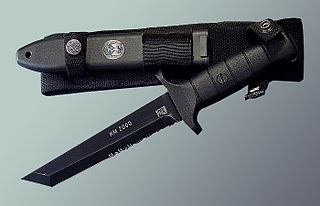
The KM2000 is the standard combat knife of the German Bundeswehr, mostly used by the German Army. The knife is manufactured in Germany by the Eickhorn-Solingen company.
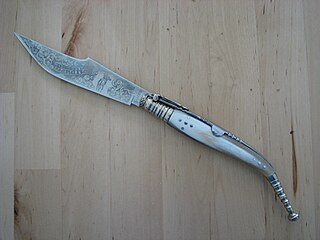
The navaja is a traditional Spanish folding-blade fighting and utility knife.

W.R. Case & Sons Cutlery Company is an American manufacturer of traditional pocket knives, fixed blades/sporting knives, kitchen knives, limited edition commemoratives and collectibles. The company originated in Little Valley, New York, around the turn of the 20th century, before relocating to its current home, Bradford, Pennsylvania, in 1905. The company's namesake, William Russell Case, first made knives with his brothers under the name Case Brothers Cutlery Company. His son, John Russell ("Russ") Case, worked as a salesman for his father's company before founding W.R. Case & Sons.
Imperial Schrade Corp. was an American knife manufacturer of hunting knives, pocketknives, utility knives, and bayonets during the 20th and early 21st centuries. The consolidation of five forerunner companies, including its namesakes, the Imperial Knife Company, founded 1916, and the Schrade Cutlery Company, founded in 1904, Imperial Schrade manufactured its products in the United States and Ireland and sold through hardware stores, department stores, and on military bases. The original company's fortunes declined and in 2004 it entered into bankruptcy where all equipment and intellectual property was sold off to reimburse creditors. The name and intellectual property was bought by Taylor Brands and used for marketing purposes.

The douk-douk is a French-made pocket knife of simple sheet-metal construction. It has been manufactured by the M. C. Cognet cutlery firm in Thiers, France, since 1929.

Columbia River Knife & Tool, Inc. (CRKT) is an American knife company established in 1994, and currently based in Tualatin, Oregon, United States. The company's president and sales executive is Rod Bremer and the finance executive is Peggy Bremer.
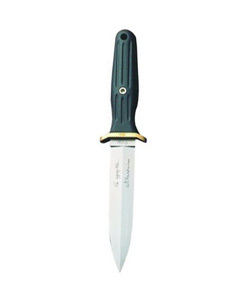
The Applegate–Fairbairn fighting knife is a combat knife designed by Colonel Rex Applegate and William E. Fairbairn as a version of the Fairbairn–Sykes fighting knife. The blade has a similar double-edged dagger profile, but is wider and more durable. It features a different handle, made most commonly of Lexan plastic with adjustable lead weights which can change the knife's balance-point. Later models and some custom variants included weights made from pure Teflon, tungsten, stainless steel and aluminum. The blade profile was also changed from a V-grind to a convex, or "appleseed" profile. While this changed the effectiveness of the blade in puncturing, cutting and slicing, it does not lend itself to being sharpened in the field by an inexperienced user. The current production model made by Böker in Solingen, Germany, uses a fiberglass reinforced delrin handle which solves the issues with earlier models where the handle would crack if exposed to heat.

A fighting knife has a blade designed to most effectively inflict injury in close-quarters physical confrontations. The combat knife and the trench knife are examples of military fighting knives.
















